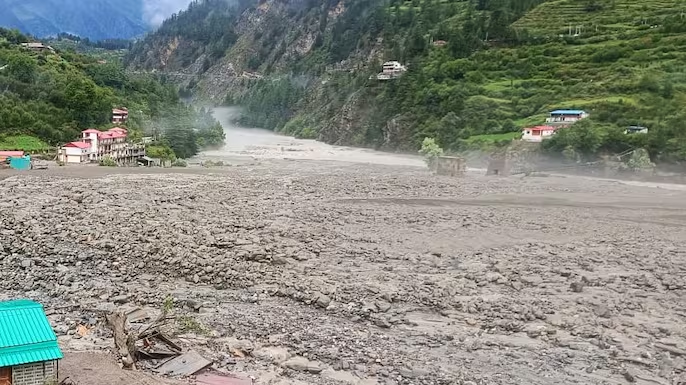Uttarakhand Cloudburst 2025: A Natural Calamity That Shook the Nation
On the stormy night of August 4, 2025, the serene and sacred lands of Uttarakhand were shaken by a catastrophic cloudburst that would leave an indelible mark on the region’s geography and its people. Known for its pristine landscapes and spiritual significance, Uttarkashi—a district nestled in the lap of the Himalayas—found itself in the crosshairs of a natural disaster of immense magnitude.
By 9:30 PM, the weather had already begun to turn ominous. Meteorological satellites had detected unusually high moisture build-up over the region, but the severity of what was to come was still uncertain. Within minutes, the skies exploded with torrential rain, strong winds, and a barrage of hailstones. It wasn’t just rain—it was a cloudburst, a phenomenon where highly concentrated rainfall dumps over a small area in a very short time. This triggered flash floods, landslides, and widespread destruction in the villages of Makudi, Laksheshwar, and surrounding hamlets.
The locals, mostly unprepared for such an intense disaster, faced the wrath of nature as muddy torrents surged through the valleys, uprooting trees, collapsing homes, sweeping away bridges, and washing away livestock. Panic gripped the region. The darkness of the night was punctuated by the eerie sound of gushing waters, cries for help, and the distant rumble of crumbling hills.
Emergency services were instantly mobilized, but the damage to roads and communication lines significantly delayed rescue operations. The first responders—often villagers themselves—worked through the night, pulling out survivors from under rubble, setting up makeshift shelters, and lighting bonfires to signal for help.
Among the most heart-wrenching sights was the devastation in the village of Laksheshwar, where an entire stretch of homes was buried under a landslide triggered by the cloudburst. Survivors, covered in sludge and in shock, wandered aimlessly looking for their families. One elderly woman, her sari soaked and torn, clutched a photograph of her son who had gone missing in the flood. The local school, which had recently reopened after monsoon vacations, was completely submerged—its students now scattered, some missing, some found miles away, rescued by villagers downstream.
While the initial death toll stood at 7, by early morning it was clear the numbers would rise. Over two dozen people were reported missing, and hundreds were displaced. The Army and NDRF were alerted, and within hours, helicopters and emergency personnel began arriving despite difficult flying conditions.
This was only the beginning. The calamity would go on to reveal the region’s infrastructural vulnerabilities, the slow pace of climate adaptation, and the human cost of ignoring environmental red flags. In the following parts, we will delve into the rescue efforts, political response, climate science behind the cloudburst, and most importantly, the voices of resilience that rose from Uttarakhand’s devastated valleys.
As dawn broke on August 5, 2025, the full extent of the Uttarakhand cloudburst disaster became grimly visible. The murky light of early morning revealed a scarred landscape: hillsides gouged by landslides, roads split and swept away, and entire stretches of villages either submerged or flattened. The air was thick with mud, debris, and grief. In the midst of this destruction, rescue operations began—slowly, but with unwavering urgency.
The Indian Army’s Northern Command, along with multiple teams from the National Disaster Response Force (NDRF), launched a large-scale coordinated response. The initial challenge was sheer accessibility. The main roads to Uttarkashi had been either washed away or blocked by massive boulders and felled trees. With land routes largely impassable, the first wave of rescue personnel had to be airlifted in via military helicopters from Dehradun and Rishikesh. Despite low visibility and turbulent air currents, the pilots pushed through to drop relief supplies and evacuate the critically injured.
By mid-morning, makeshift helipads were established near relatively stable terrain in villages such as Matli and Bhatwadi. IAF choppers began sorties to evacuate elderly residents, pregnant women, and children. At the same time, NDRF teams—many of them trudging on foot through treacherous terrain—reached Makudi and Laksheshwar. Equipped with life detectors, stretchers, and satellite phones, they started pulling survivors out from under debris and locating those stranded on hillocks and rooftops.
One such rescue made headlines. A 10-year-old boy, Veer Singh, had managed to climb atop a tree when the floodwaters surged into his village. Clinging on for over 12 hours, hungry and soaked, he was spotted by an NDRF drone camera. A team of jawans trekked nearly five kilometers through knee-deep slush and rain to bring him back. His rescue became a symbol of hope across the state.
Medical camps were quickly set up in relatively undamaged areas. Doctors from nearby districts and NGOs like Doctors Without Borders and the Indian Red Cross Society rushed in to provide triage. Common injuries ranged from fractures and contusions to waterborne infections. Tragically, there were also cases of severe hypothermia and trauma-induced shock. In one tent, a young mother held her newborn wrapped in donated woolens—her child born just two days before the cloudburst—both miraculously alive.
Volunteers—both local and from neighboring towns—joined hands with relief workers. Gurudwaras and temples opened their kitchens, cooking in bulk and sending food packets with whatever vehicles could navigate the terrain. Social media also played a vital role. Videos of the destruction circulated rapidly, prompting nationwide fundraising drives and calls for blood donation. Within hours, relief material from across India began its journey toward the hills.
Despite these efforts, challenges persisted. Many smaller hamlets remained cut off. Communication towers had been damaged, making it difficult to coordinate operations. Satellite phones became lifelines, and makeshift wireless networks were deployed by ITBP teams. Nightfall brought renewed danger—shifting debris, loose boulders, and fears of more rain. But operations did not stop.
The Chief Minister of Uttarakhand arrived in Dehradun by afternoon and held an emergency press briefing. He declared a state of emergency, sanctioned ₹500 crore in immediate relief, and urged citizens to avoid panic. The Prime Minister’s Office also issued a statement expressing solidarity and promising full central support. Within hours, Union Ministers for Home Affairs and Environment were scheduled to visit the region.
But even with political will and boots on the ground, the road to recovery was long and unpredictable. Geologists from the Wadia Institute and disaster analysts from NDMA warned of more landslides as soil saturation increased. Relief had to race against time—not just to save lives, but to prevent secondary disasters.
In the middle of it all were the people—resilient, grieving, helping one another, and finding strength amid tragedy. There was a farmer who ferried water on his tractor for an entire cluster of displaced villagers, and a schoolteacher who turned the ruins of her classroom into a shelter for those without homes. Stories like these stitched the torn fabric of community back together, thread by fragile thread.
As rescue operations entered their second full day, the mood across India had shifted—from shock and sadness to determination. What had begun as a natural disaster was now unfolding into a test of national response, empathy, and resilience.
As the rescue operations progressed and the extent of the disaster became clearer, Uttarakhand transitioned into the most crucial and delicate phase—relief and rehabilitation. The immediate aftermath of any natural calamity tests the resilience of government machinery, the solidarity of the community, and the endurance of those affected. In Uttarkashi, all three were pushed to their limits.
The Arrival of Aid
By the morning of August 6, 2025, relief teams from the National Disaster Response Force (NDRF), Indian Army, Indo-Tibetan Border Police (ITBP), and state disaster units had set up base camps near the worst-hit villages of Makudi, Laksheshwar, and Siror. From helicopters to ropeways and even on foot through treacherous terrain, aid began to reach survivors stranded without food, water, or shelter.
Tents were erected on higher ground to house those who had lost everything. Medical teams treated injuries ranging from broken limbs and infections to hypothermia and trauma. Mobile hospitals equipped with X-rays, ultrasound machines, and emergency surgery units were flown in. NGOs and local volunteer networks played a vital role in setting up food kitchens, distributing blankets, and counselling survivors.
Restoring Connectivity and Communication
Roads leading to interior villages had been entirely wiped out by landslides or submerged under sludge. Engineers from the Border Roads Organisation (BRO) began around-the-clock operations to rebuild essential routes. Satellite phones and portable radio units became the lifeline for coordinating relief in areas where mobile networks had collapsed.
Electricity poles were downed, and water pipelines were destroyed. Temporary generators powered critical rescue hubs, while makeshift water filtration systems were flown in by the Indian Air Force. The challenge was not only to rebuild but to do so faster than the next wave of rainstorms.
Government Action and Announcements
Prime Minister Narendra Modi held an emergency high-level meeting and announced ₹1,000 crore as immediate relief for Uttarakhand under the National Disaster Response Fund. Additionally, an ex-gratia of ₹4 lakh was announced for the families of the deceased and ₹50,000 for the injured.
Uttarakhand Chief Minister Pushkar Singh Dhami visited the disaster site, assuring citizens that long-term rehabilitation plans were underway. He promised reconstruction of homes, compensation for livestock and property loss, and reforestation initiatives to stabilize landslide-prone zones. Temporary schools and anganwadi centres were set up to provide continuity in education and childcare.
Stories of Hope Amidst Despair
As aid poured in, stories of human spirit and community resilience began to surface. In one such tale, a local shepherd named Devraj risked his life to guide 23 children to safety across a raging stream by creating a human chain using ropes and bamboo sticks. Elsewhere, a group of women in Laksheshwar organized food distribution for over 500 villagers from whatever supplies they could salvage.
Psychological counselling centres were set up with support from the Red Cross and AIIMS-trained professionals. Many survivors, especially children, were reported to be suffering from post-traumatic stress. Mental health, often overlooked in disaster responses, took a front seat this time—highlighting a more holistic approach to rehabilitation.
Reckoning with the Lessons
As Uttarakhand struggled to stand back on its feet, environmentalists, urban planners, and climatologists began a parallel conversation—one that would define the state’s future. Why was Uttarkashi so vulnerable despite repeated alerts over the past decade? What role did unchecked construction and deforestation play in aggravating the disaster?
Satellite imagery revealed how forest cover had significantly reduced in upper catchment areas, making soil erosion and landslides more severe. Illegal encroachments near riverbanks, unregulated tourism, and a lack of adherence to ecological zoning regulations came under scrutiny. The monsoon fury was not just an act of nature—it was, in part, an outcome of prolonged neglect.
The Road Ahead
The road to full recovery is long and winding. Beyond immediate rebuilding, Uttarakhand must now focus on climate-resilient infrastructure, stricter environmental regulations, early warning systems, and community disaster preparedness.
The Uttarakhand cloudburst of 2025 may go down in history as a calamity, but also, perhaps, as a turning point. One that reminded India—and the world—of the fragile relationship between man and nature.
In the days following the Uttarkashi disaster, India witnessed not just an administrative response but also an intense political reckoning. The Uttarakhand cloudburst had torn through more than just villages—it had pierced through decades of unaddressed policy gaps, environmental negligence, and reactive governance.
A House United, Yet Divided
Both Houses of Parliament held an emergency session on August 7, 2025, where the disaster became the focal point of national debate. Prime Minister Narendra Modi addressed the Lok Sabha, expressing grief over the tragedy and promising “not just relief, but reform.”
“We stand with the people of Uttarakhand. But standing with them today also means changing our approach for tomorrow,” he said.
Opposition leaders across party lines extended support to the affected, but also held the Centre and State accountable for years of ecological mismanagement. Congress leader Rahul Gandhi pointed to the increasing frequency of such disasters as a direct outcome of ignoring climate resilience in development models.
“The Himalayas are crying, and our policies are deaf,” he remarked.
Environmental parties like the AAP and CPI(M) demanded an urgent nationwide audit of infrastructure projects in sensitive ecological zones, including the Char Dham road project and hydropower dams in the region.
The Chief Minister’s Challenge
Uttarakhand Chief Minister Pushkar Singh Dhami, under intense public scrutiny, addressed a press conference from Dehradun.
“Relief is not just about compensation; it is about rebuilding safer. And we commit ourselves to that goal,” he said, announcing a ₹2,500 crore rehabilitation and climate adaptation plan.
The plan included:
- Permanent relocation of villages in high-risk zones.
- Strict curbs on hill-cutting and unregulated tourism development.
- Forest regeneration in the upper reaches of Uttarkashi and Chamoli.
- Strengthening of the State Disaster Response Force (SDRF) and community awareness programs.
The move was welcomed but was also met with skepticism by activists who feared another round of promises without implementation.
Environmentalists Speak Out
As television screens and social media feeds replayed drone footage of flattened homes and collapsed hillsides, India’s environmental experts seized the moment to speak louder than ever.
Sunita Narain, director of the Centre for Science and Environment (CSE), called the cloudburst “a man-made amplification of a natural event.” She warned that more such extreme weather episodes were inevitable unless India drastically changed its mountain development policies.
“A cloudburst is sudden, yes. But our vulnerability to it is the result of slow and deliberate choices,” she wrote in an editorial.
Climate scientists from IIT Roorkee and IMD (India Meteorological Department) explained how the growing intensity of monsoons was linked to both global warming and regional land-use changes. They called for better meteorological modeling, a denser network of rain gauges, and real-time satellite tracking of convective clouds in Himalayan regions.
Voices from the Ground
Amid this national discourse, local activists and villagers had their own truths to share. Gram pradhans (village heads) from affected areas submitted memorandums demanding legal action against unauthorized construction lobbies and mining mafias that had stripped the region’s ecological buffer zones.
Savitri Devi, a resident of Siror village, gave an impassioned testimony before a local panchayat: “We were not just hit by rain. We were buried under decades of greed.”
Young activists from Dehradun and Rishikesh began organizing awareness drives and online petitions demanding environmental justice, calling the disaster a “wake-up call that must become a turning point.”
Media and Public Perception
For once, mainstream media went beyond sensational visuals. Editorials, think-pieces, and documentaries focused not only on the tragedy but the structural failures that made it worse.
News channels held primetime debates on eco-sensitive zone violations, while newspapers like The Hindu and Indian Express ran exposés on how construction tenders were often cleared without Environmental Impact Assessments (EIA). Social media trends like #SaveTheHimalayas and #ClimateJusticeForUttarakhand gained traction nationwide.
The shift in tone—from sympathy to accountability—was palpable. This wasn’t just another disaster in the mountains. It was, as several journalists noted, “India’s climate disaster moment of truth.”
Also Read : Mohali Oxygen Plant Blast Kills 2, Injures 3 in Massive Explosion; Panic Grips Industrial Zone








